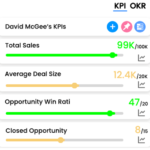Key Performance Indicators Examples

Net Income
Net income, also known as net profit or net earnings, is a measure of a company’s financial performance that represents the amount of money left over after all expenses have been paid. It is used to measure a company’s profitability and to identify areas where improvements can be made.
The formula for net income is:
Net Income = Revenue – Expenses
or
Net Income = Total Revenue – (Cost of Goods Sold + Operating Expenses + Depreciation + Amortization + Interest + Taxes)
It is calculated by subtracting the sum of all expenses from the total revenue for a given period.
- Total Revenue is the amount of money a company generates from the sale of its products or services.
- Cost of Goods Sold (COGS) includes the direct costs associated with producing and selling the company’s products or services.
- Operating Expenses are the ongoing costs associated with running the business, such as rent, utilities, and salaries.
- Depreciation and Amortization are non-cash expenses used to allocate the cost of long-term assets over time.
- Interest is the cost of borrowing money, such as loans or bonds.
- Taxes are the amount of money a company must pay to the government in taxes.
For example, if a company has revenue of $1,000,000, COGS of $300,000, Operating Expenses of $400,000, Depreciation of $50,000, Amortization of $20,000, Interest of $30,000 and Taxes of $50,000, the net income would be $200,000 ($1,000,000 – ($300,000 + $400,000 + $50,000 + $20,000 + $30,000 + $50,000))
It’s important to track net income over time, compare it against industry benchmarks and historical data, to identify areas where the company’s operations can be improved. It’s also important to track net income by different segments, such as by different teams, products, or locations, in order to identify where the problem is and take action to improve net income.
Net income is an important metric for companies, as it allows them to evaluate the effectiveness of their operations and make decisions about investments, finances, and growth. It also used to measure the company’s profitability and to identify areas where improvements can be made.
It’s also important to keep in mind that net income should be aligned with the business requirements and the needs of the end-users, a high net income can indicate a strong financial position, but it can also mean that the company is not investing enough in growth opportunities or not investing in the future.
Measure what matters for your business with KPIs
Track business performance with real time key metrics against targets in one place without the need for multiple dashboards or reports
